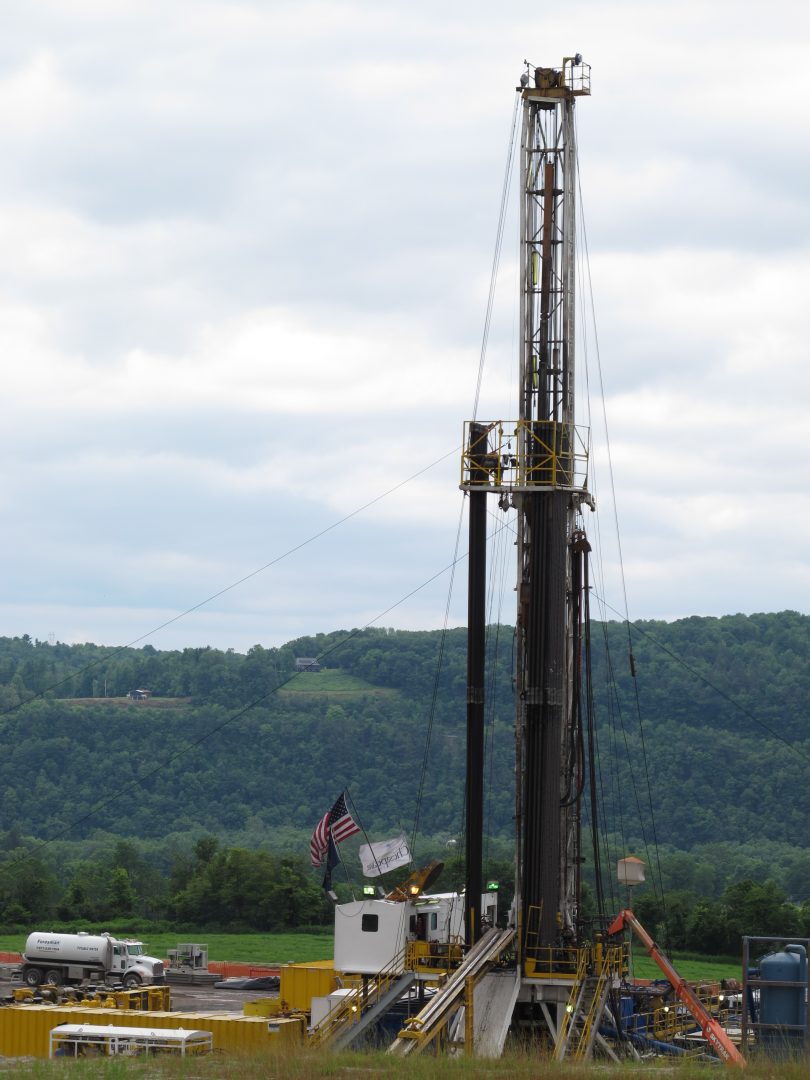
A Bradford County drilling rig
Scott Detrow / StateImpact Pennsylvania


A Bradford County drilling rig
Scott Detrow / StateImpact Pennsylvania

Scott Detrow / StateImpact Pennsylvania
A Bradford County drilling rig
The Department of Environmental Protection has a list of accredited labs. The state requires drilling companies to test water wells that lie within 1000 feet of a gas well. If water quality changes within a certain period of time, the gas company is held liable. But many residents prefer to conduct their own water testing. In that case, the state does provide some guidelines. Both the DEP and the private labs have broken these tests down in tiers, with the first tier being the least extensive, but also cheaper than the other tiers.\The most common pollutants to test for are salts, metals and organic materials. The cheapest level of testing includes total dissolved solids, sodium, methane and ethane, as well as iron, manganese and barium. The cost for this test would range between $200 to $300 dollars.
Some residents can choose to use results from the industry tests, which are done be accredited independent labs. Those are free, but landowners should check with the drillers to make sure they will be given a copy of the results.
Speaking of water and drilling, just how much fluid goes into each well, and where does it come from? The average well pad uses about 4 million gallons of H2O a day, during fracking operations.
All told, the commission estimates drillers are using about 30 million gallons of water each day, across Pennsylvania.
Drillers, who have gotten a bad rap for their water usage, are quick to put that figure in comparison. “4 million gallons per well sounds like a lot,” said Range Resources’ Matt Pitzarella, “but even if we tripled our expected usage, we’d [still use] less than one half of one percent of the state’s [water consumption.] We would be less than golf courses.”
“We could frack 100,000 wells,” Pitzarella continued, “and use less than a third of one percent of the water that’s in Lake Erie alone.”
Drillers obtain water from municipal water systems, or nearby rivers and streams. When they’re taking water from a tributary or ground source, they need to obtain permission from the commonwealth or Susquehanna River Basin Commission.
After drilling is complete, energy companies need to deal with the leftover fracking fluid, which is laden with chemicals, methane and other particles picked up during its high-pressure journey underground. Some of that “flowback” is reused after it gets treated. The most concentrated fluid remaining from treatment, is trucked to what’s called a “deep injection well,” or “brine disposal well.” That’s a cased well where the highly salty, or contaminated water, gets shot deep into the earth. Pennsylvania has only 8 of these wells, so most drillers truck their waste to Ohio.
Range Resources has an injection well in Erie County, which is permitted to take the most frack water in the state at 45,000 barrels per month. Some take as low as 4200 barrels per month, but most of them can take about 30,000 barrels a month. EXCO Resources operates two in Clearfield County. Other operators include Columbia Gas, Cottonwood and CNX Gas. Those wells are in Beaver, and Somerset counties. When it comes to pressure, the wells are permitted to take between 1300 to about 3200 pounds per square inch. The two newest wells will be operated by Bear Lake Properties in Warren County. All eight wells are in the western part of the state.
Finally, StateImpact took a look at whether or not fracking has been linked to earthquakes. The answer? “Jim Coleman, a geologist with the U.S. Geological Survey told StateImpact that injecting fluid under high pressure does cause measurable seismic activity. But he says the earthquakes are typically too small to be noticed and didn’t think there was any evidence that fracking would have caused the Virginia quake.” Some studies, however, are ongoing.
What should StateImpact answer next? That’s where you come in. Click on the link below, take our poll, and let us know which burning question to tackle.
StateImpact Pennsylvania is a collaboration among WITF, WHYY, and the Allegheny Front. Reporters Reid Frazier, Rachel McDevitt and Susan Phillips cover the commonwealth’s energy economy. Read their reports on this site, and hear them on public radio stations across Pennsylvania.
(listed by story count)
StateImpact Pennsylvania is a collaboration among WITF, WHYY, and the Allegheny Front. Reporters Reid Frazier, Rachel McDevitt and Susan Phillips cover the commonwealth’s energy economy. Read their reports on this site, and hear them on public radio stations across Pennsylvania.
Climate Solutions, a collaboration of news organizations, educational institutions and a theater company, uses engagement, education and storytelling to help central Pennsylvanians toward climate change literacy, resilience and adaptation. Our work will amplify how people are finding solutions to the challenges presented by a warming world.